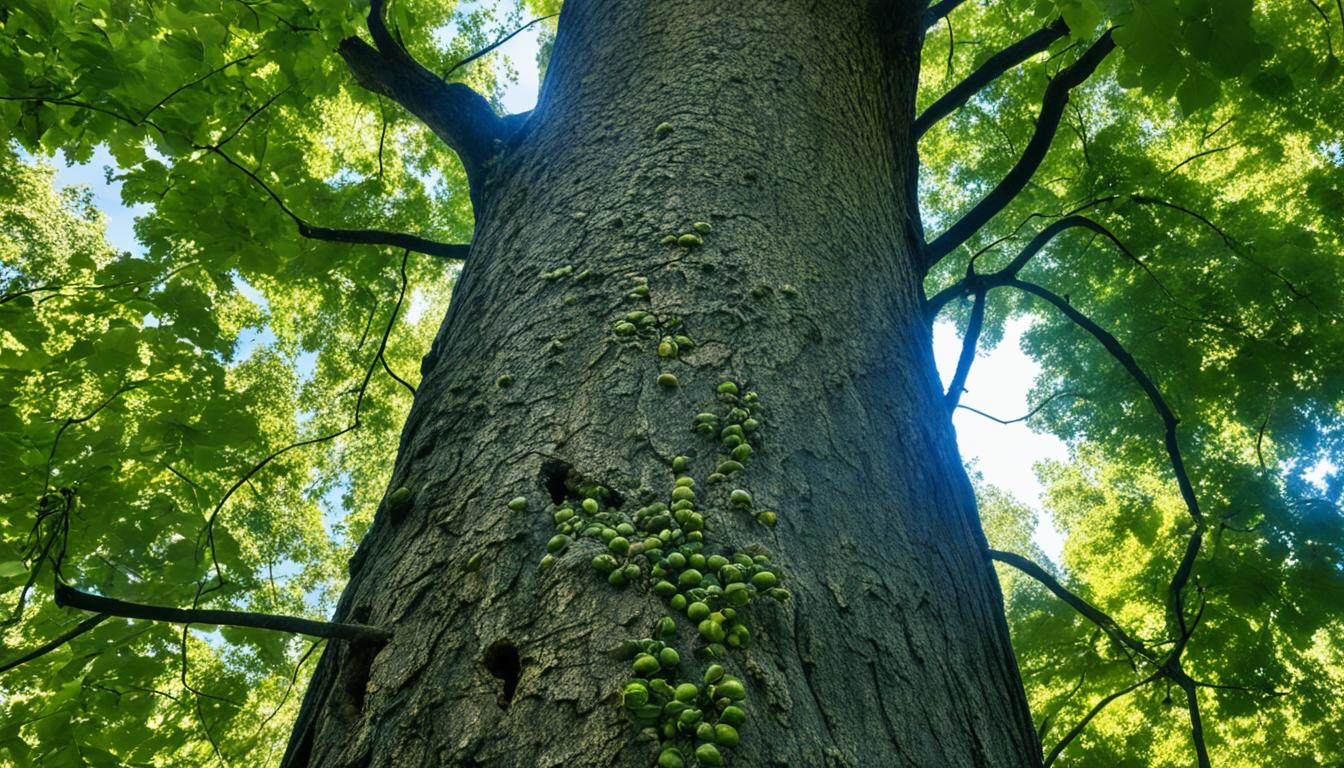Walnuts are tasty and full of nutrients. You can pick them from your walnut tree with the right steps. This guide will show you how to harvest walnuts, from knowing when they’re ready to how to collect, hull, dry, and store them. It’s great for those with walnut trees or thinking of planting one.
Walnut trees can get really big, up to 100 feet tall and 50 feet wide. This can be a challenge for some gardens. It’s important to know when to pick your walnuts and how to do it right. The best time to harvest is usually from early September to early November, depending on the type and where you live.
It’s also important that at least 85% of the walnuts can be easily taken from the tree before you start harvesting. This means the walnuts are ready and won’t be taken by insects or birds. Knowing the best time and how to pick them helps you get a good harvest and reduces waste.
When Are Walnuts Ready to Pick?
Harvesting walnuts at the right time is key for a great crop. There are two main types – English and black walnuts. Each type shows its own signs of being ready.
English and Black Walnut Varieties
English walnuts are ready from late August to September. Black walnuts are ready a bit later, in October. Black walnuts have a thicker shell and taste stronger than English ones. Both trees can grow up to 100 feet tall.
Signs of Ripening for Walnut Harvesting
- Look for the walnut’s fibrous, leather-like sheath to start splitting open, indicating the nuts are beginning to ripen.
- Crack a few nuts open to check for a browning membrane and loosening hull, which signifies they are ready to pick.
- Delay harvesting too long, and the outer husks will become soft and black, leading to a bitter, rancid flavor.
Walnuts are usually harvested from early September to early November. The best time to pick is when the kernel is light in color and the brown membrane comes off easily.
| Walnut Variety | Typical Harvest Time | Shell Thickness | Flavor Profile |
|---|---|---|---|
| English Walnut | Late August – September | Thinner | Milder |
| Black Walnut | October | Thicker | More Intense |
Knowing the special traits and ripening signs of English and black walnuts helps you pick them at the best time. This ensures the best flavor and quality.
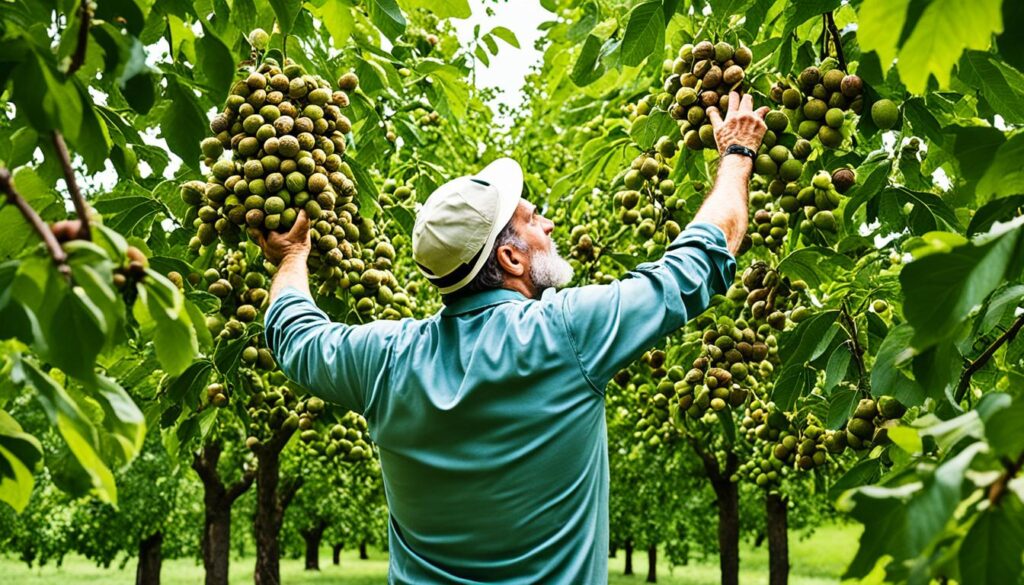
How to Harvest Walnuts?
Walnut Harvesting Season
The best time to pick walnuts is from late August to October. This is 3-7 years after planting, based on the type and conditions. During this period, the nuts are fully grown and start falling from the trees.
Tools Needed for Harvesting Walnuts
You’ll need some key tools for walnut harvesting:
- A pole or pole with a hook – Use this to gently shake the walnut tree branches and dislodge the ripe nuts.
- Gloves – The walnut hulls can stain your hands, so wear rubber gloves when handling the freshly picked nuts.
- A pocket knife – This is handy for hulling the walnuts by cutting through the fibrous, leather-like sheath.
Collect the walnuts right after they fall to avoid mold or ants. Start drying them immediately for the best flavor and storage life.
| Walnut Variety | Harvesting Timeline | Drying Time | Storage Life |
|---|---|---|---|
| English Walnuts | Late September to Early November | 1 to 4 weeks | Several months in shell, longer shelled and refrigerated or frozen |
| Black Walnuts | September to October | 2 to 3 weeks | 1 month refrigerated, 2 years frozen |
Using these walnut harvesting tips and tools will ensure a great harvest. You’ll get a lot of high-quality walnuts to enjoy.
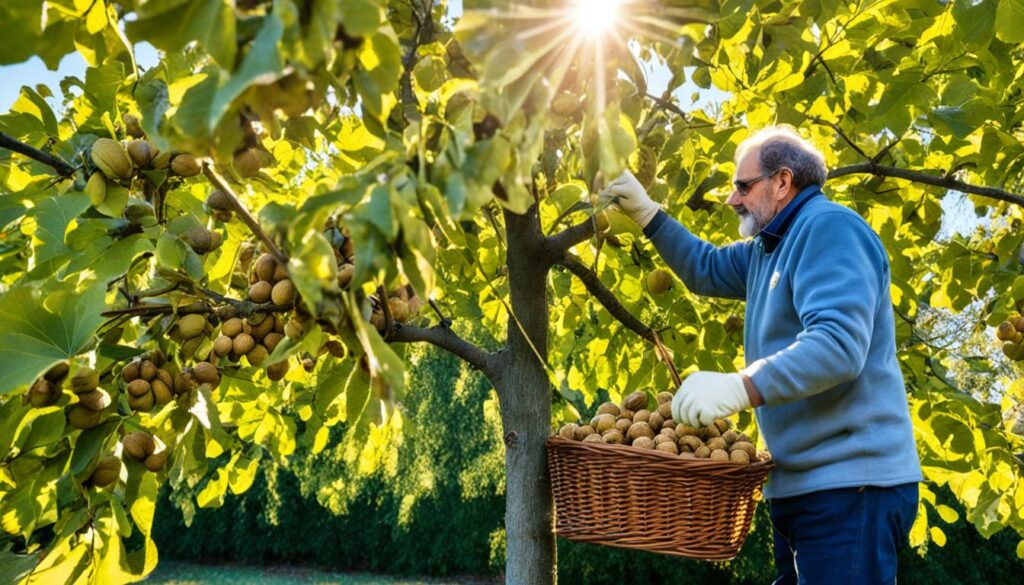
Avoiding Bitter Walnuts
Harvesting walnuts at the right time is key to avoiding a bitter taste. The longer the hull stays on, the nut gets more bitter from tannins. So, it’s best to pick them when the green husks start to open and the nuts hit the ground.
Waiting too long can make the husks soft and black, leading to a bad taste. Research shows that walnuts left out too long become bitter. This happens because the hulls, full of tannins, soak into the nut meat.
The best time to pick walnuts is from September to October when they’re ripe. Picking them when the hulls split and they fall ensures they taste sweet. This is very important for black walnuts to stop mold from growing.
“Harvesting the walnuts as soon as the hulls start to split open and the nuts drop will help ensure a sweet, flavorful final product.”
Knowing when to pick walnuts helps avoid a bitter taste. This way, you can enjoy the full, rich flavor of this great nut.
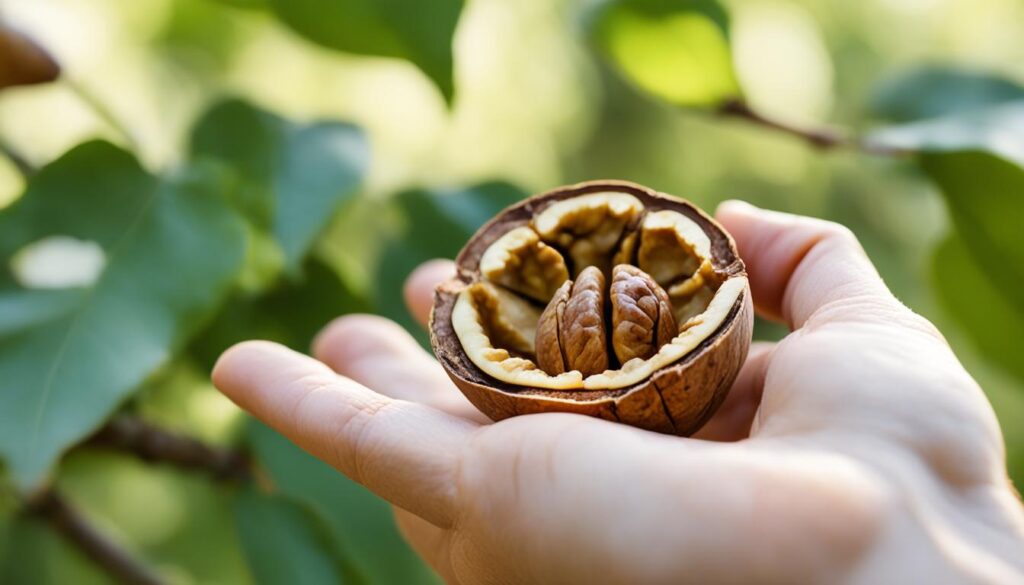
Walnut Picking Techniques
Harvesting walnuts needs a careful plan to get the ripe, top-quality nuts. Start by using a pole or a pole with a hook to shake the walnut tree’s branches. This helps you get nuts from the top, which ripen later than those at the bottom.
After shaking the branches, the walnuts will fall to the ground. It’s important to pick them up right away. This stops mold or bugs from getting to them. Tools like rakes or baskets make it easy to collect the nuts after shaking the tree.
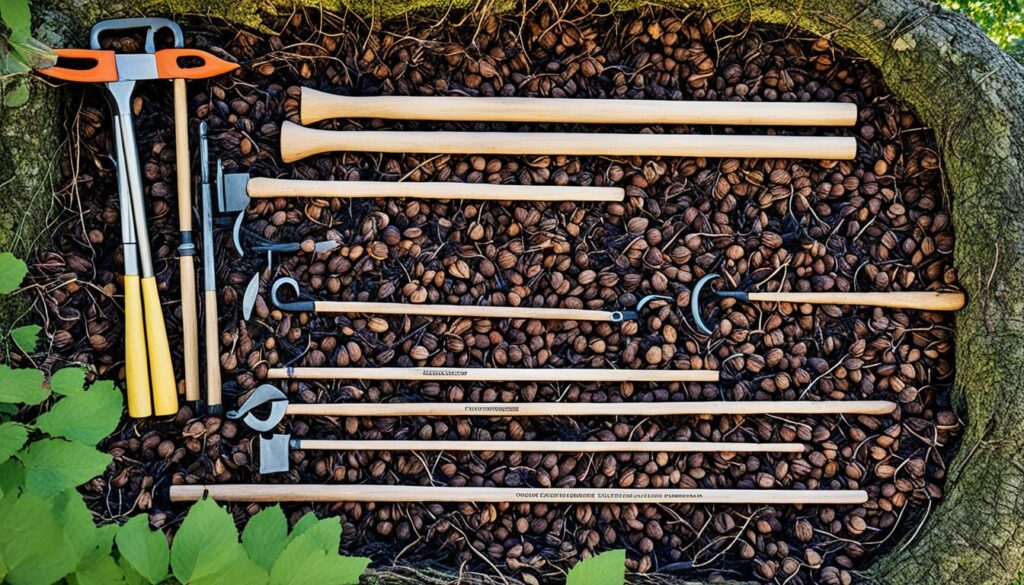
For successful walnut harvesting, it’s key to use efficient walnut tree shaking methods and walnut gathering tools. This way, you can collect the walnuts fast and well. It makes sure your methods for collecting walnuts get you the best yield and quality.
Hulling and Cleaning Freshly Picked Walnuts
The walnut hulling process is key to getting your fresh walnuts ready for storage and eating. After picking the walnuts that have fallen from the tree, it’s time to remove the tough, green outer hulls. This step cleans the nuts and keeps your hands from getting stained by the natural phenols in the hulls.
Use a sharp pocket knife to slice through the soft, spongy hull in one motion. Don’t press too hard, as the inner shell is very hard. Gently twist to remove the hull and as much of the fibrous material as you can. After hulling, wash the nuts well to get rid of any leftover husk pieces. Lay the cleaned nuts out in a shaded area to start drying.
| Task | Estimated Time |
|---|---|
| Hulling 25 walnuts | 1 hour |
| Cleaning and washing 400 walnuts | 16 hours |
| Curing freshly cleaned walnuts | 4-5 weeks |
The walnut hulling and cleaning process takes a lot of work, but it’s worth it. With patience and the right tools, you’ll end up with a lot of clean, dry walnuts. Always wear protective gloves and clothes to avoid stains, and make sure to dispose of the hulls properly to prevent unwanted growth or smells.

“Hulling walnuts while singing Peppermint Twist or Twist and Shout is a fun way to make the task more enjoyable.”
How to Harvest Walnuts From a Walnut Tree?
Harvesting walnuts from your own tree is rewarding and tasty. Whether you have an English or black walnut, the walnut harvesting methods are similar. Here’s a step-by-step guide to help you get the most from your tree this season.
- Use a pole or a hook on a pole to gently shake the tree’s branches. This will help dislodge the nuts and make them fall.
- Quickly pick up the fallen walnuts. Leaving them out can cause mold or bug damage. So, it’s best to collect the freshly fallen walnuts right away.
- Wear rubber gloves when handling the nuts. The hulls can stain your skin.
- After gathering all the nuts, hull and clean them. Then, dry and store them for later use.
Be careful when using walnut tree shaking techniques. You don’t want to hurt the tree or lose too many nuts. With practice, you’ll get better at harvesting your walnuts and enjoy the results.
“The nuts fall to the ground in late September and early October, making it the ideal time for harvesting.”
By following these steps, you can have a great walnut harvest from your tree. Happy harvesting!
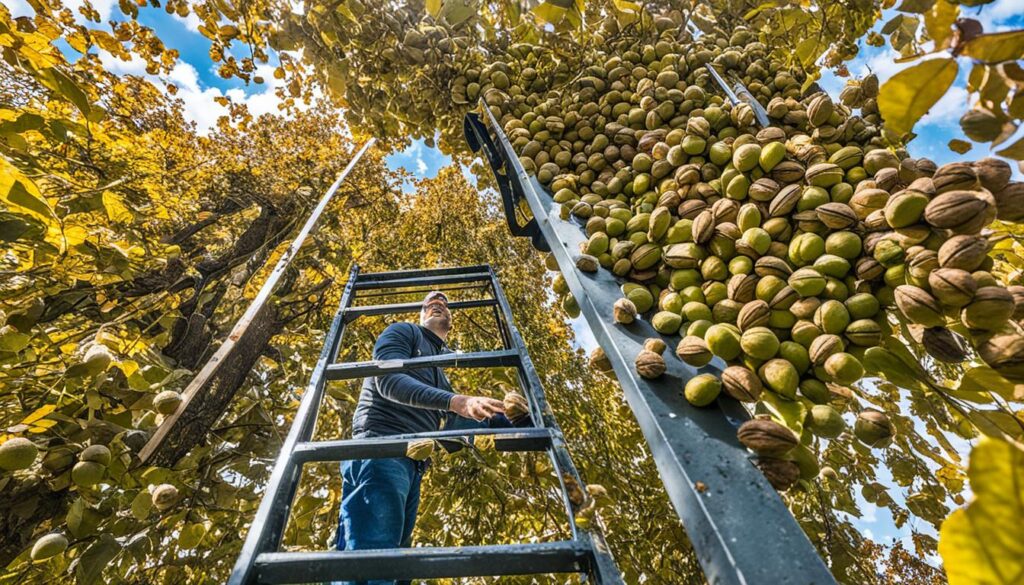
Drying and Curing Walnuts for Storage
After harvesting walnuts, drying and curing them is the next important step. This process is key to keeping your walnuts fresh for a long time. It helps keep their great taste and texture.
Importance of Drying and Curing
Fresh walnuts have a lot of moisture that can cause them to spoil if not dried. Drying and curing remove this moisture. This stops mold, bacteria, and other problems that could ruin your walnuts. By drying and curing your walnuts right, they can last up to a year in good storage conditions.
Methods for Drying Walnuts
To dry your walnuts well, follow these steps:
- Lay the fresh walnuts out in a single layer on a clean, dry surface. Use something like a screen or tarp in a shaded, airy spot.
- Check on the walnuts every day and mix them up. This helps them dry evenly.
- Drying usually takes 3-4 days, depending on your area’s weather and humidity.
- When the walnuts are dry and their shells crack open easily, they’re ready for curing.
Getting your walnuts dry and cured right is key to extending their shelf life. It also keeps them in good storage conditions. By doing this, you make sure your walnuts are perfect for storing and eating for a long time.
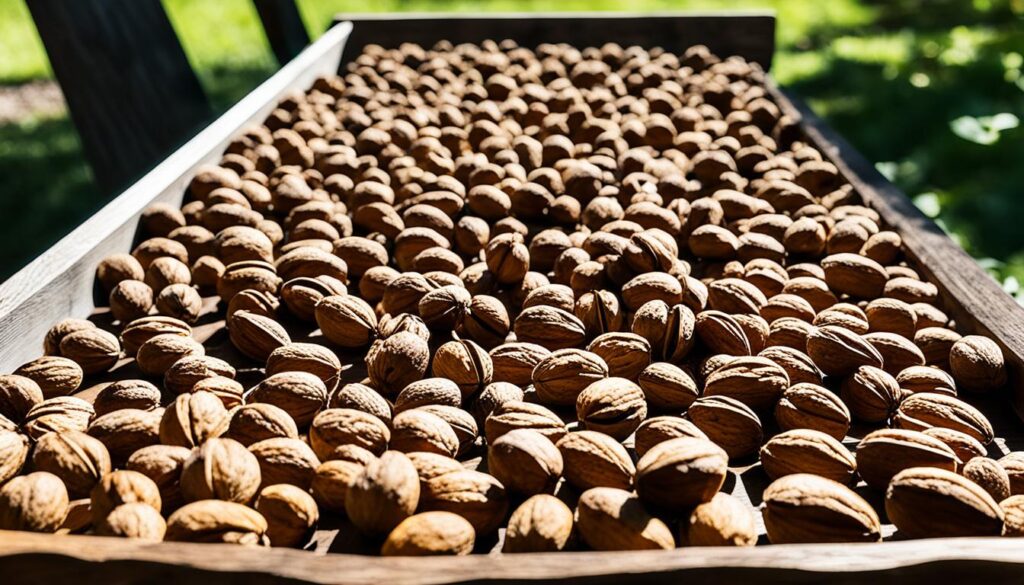
Conclusion
Harvesting walnuts from my own tree has been rewarding. I learned how to tell when they’re ripe and how to dry and cure them. This way, I get to enjoy a steady supply of these nutritious nuts.
Cracking open the shells to get to the nutmeats is very satisfying. I love using these walnuts in baking and making nut butters. Being able to control the quality of my walnuts is a big plus.
I’m excited to keep improving my walnut harvesting and processing. I want to find new ways to use these nuts in my cooking. Sharing my harvest with neighbors or enjoying them myself brings me pride and a connection to the land. Harvesting walnuts has become a tradition I look forward to sharing with my family.
FAQ
What are the different varieties of walnut trees?
There are English and black walnut varieties. Black walnuts have a thicker shell and taste stronger. Both are big, deciduous trees that grow a lot.
How can I tell when walnuts are ready to be harvested?
Check for nuts with light colored kernels and a brown membrane between the halves. This means they’re ripe and ready. Waiting too long makes the husks soft and black, making the nuts taste bitter.
When is the best time of year to harvest walnuts?
Harvesting walnuts is from early September to early November. This is when they’re fully ripe and the hulls start to open.
What tools do I need for harvesting walnuts?
You’ll need a pole or pole with a hook to shake the branches. Also, wear rubber gloves to protect your hands from staining.
How do I prevent bitterness in the walnuts?
Harvest the nuts when the hulls start to split and they fall to the ground. This ensures they’re sweet and tasty. Waiting too long makes the hulls turn soft and black, making the nuts bitter.
What is the proper way to hull and clean freshly picked walnuts?
Use a sharp pocket knife to cut through the green outer hull in one go. Don’t press hard because the inner shell is hard. Then, twist off the hull and wash the nuts well to get rid of any husk bits.
How do I dry and cure harvested walnuts for long-term storage?
Lay the nuts out in a single layer in a shaded, dry spot and check on them every day. This drying process takes 3-4 days to remove extra moisture. Next, cure them for 4-6 weeks in a cool, dry place to improve flavor and texture. With proper drying and curing, walnuts can last up to a year in their shells.
